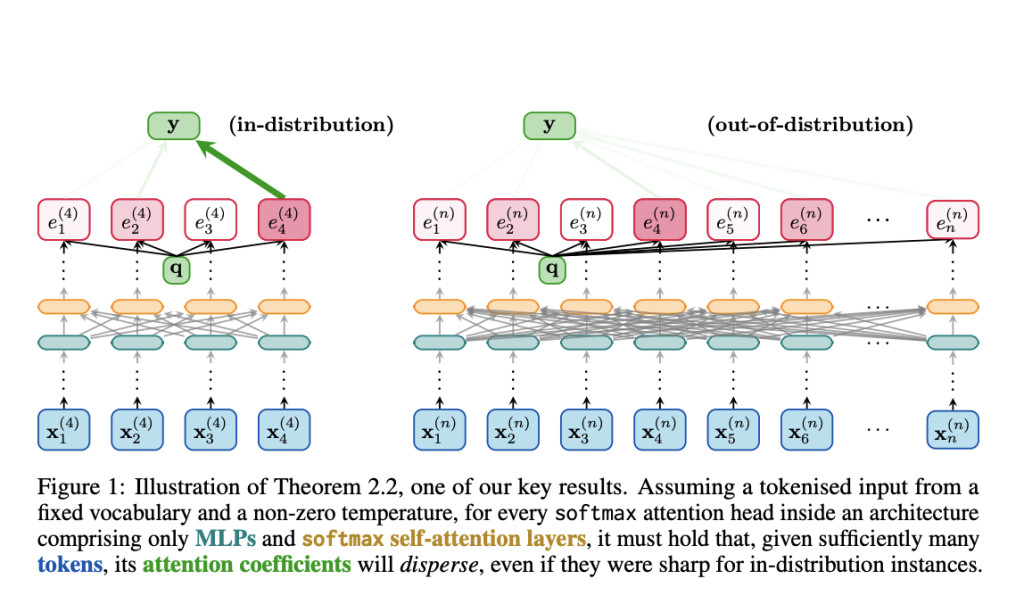

The ability to generate accurate conclusions based on data inputs is essential for strong reasoning and dependable performance in Artificial Intelligence (AI) systems. The softmax function is a crucial element that supports this functionality in modern AI models. A major component of differentiable query-key lookups is the softmax function, which enables the model to concentrate on pertinent portions of the input data in a way that can be improved or learned over time. Its significance is particularly clear in attention mechanisms, where models like Transformers must choose to focus on particular inputs in order to produce precise analyses or predictions.
AI models can accept many inputs while giving the most significant ones more weight using the softmax algorithm. It can, for instance, transform a collection of scores, known as logits, from a model’s outputs into probabilities. The model may prioritize the most significant input features by using these probabilities, which show how relevant each feature is. It is generally accepted that this function helps in the development of internal circuits in AI models, especially in architectures that use deep neural networks with attention mechanisms.Â
These circuit pathways—through which information is processed, and particular computations are carried out—are believed to enhance the predictive capacity of the model by carrying out consistent, dependable computations over a range of inputs. Thus, the softmax function is viewed as a critical element that makes it possible for these circuits to execute selective attention on data, a feature that is vital for jobs in language processing, vision, and other domains where the capacity to concentrate on particular data points is critical to success.
However, lately, there has been criticism of the notion that these softmax-based circuits are reliable in any situation. One fundamental problem is that the softmax function’s capacity to sustain acute focus diminishes with increasing data volume or item count in the input set. This indicates that softmax fails to maintain this sharpness as the quantity of inputs increases during test time, even while it can efficiently identify and rank the most pertinent inputs when working with a manageable amount of data. The effectiveness of the softmax function for jobs demanding quick decisions is limited as data scales due to the dispersion effect, in which attention shifts among inputs rather than staying concentrated on the most important ones. As the input size increases, even a straightforward task like determining the maximum value in a set of inputs gets more challenging, causing the model to spread its attention across things rather than focusing on the maximum.
This dispersion results from a basic flaw in the softmax function itself: when presented with a large number of inputs, it is unable to accurately approximate decision bounds. In order to illustrate this phenomenon thoroughly, a team of researchers in a recent study has explained how softmax tends to become less effective at finding the most pertinent data points under certain circumstances as the problem size increases. Their results cast doubt on the idea that softmax-based attention processes are always reliable, particularly regarding reasoning tasks that need selective, acute focus on a small group of inputs.
The team has suggested an adjustable temperature mechanism inside the softmax function as a workable solution to lessen this dispersion problem. The model can change its focus using Softmax’s temperature parameter, which regulates the level of concentration in its output probabilities. The model can maintain selective focus even when the input size changes by dynamically adjusting this parameter to increase sharpness. By managing softmax’s intrinsic dispersion, although ad hoc, this adaptive temperature technique makes it more robust to scaling issues during inference.
In conclusion, even though the softmax function is essential to modern AI because it helps with selective attention, reasoning systems that need to make quick decisions have a big problem because of their inability to scale to bigger input sizes. The suggested adaptive temperature mechanism is an important step towards improving AI’s reasoning abilities in increasingly complicated, data-rich contexts, which provides a promising means of supporting softmax’s performance under scaling situations. Applications that require both accuracy and scalability, like huge language models and sophisticated computer vision systems, can benefit greatly from this modification.
Check out the Paper. All credit for this research goes to the researchers of this project. Also, don’t forget to follow us on Twitter and join our Telegram Channel and LinkedIn Group. If you like our work, you will love our newsletter.. Don’t Forget to join our 55k+ ML SubReddit.
[Trending] LLMWare Introduces Model Depot: An Extensive Collection of Small Language Models (SLMs) for Intel PCs
The post Enhancing Artificial Intelligence Reasoning by Addressing Softmax Limitations in Sharp Decision-Making with Adaptive Temperature Techniques appeared first on MarkTechPost.
Source: Read MoreÂ

